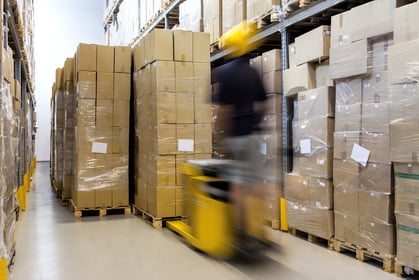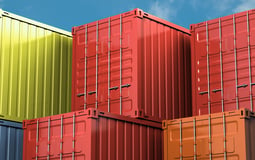How Car and Truck Manufacturers Can Reduce Logistics Costs
Brian Hoey - December 03, 2020

 In 2019, things in the commercial vehicle sector were poised for growth and transformation. Emerging markets in Asia were contributing to a rosy outlook for market growth—meanwhile, the drive towards increasingly electric and eco-conscious vehicles was driving changes in the way that vehicles were planned and produced. Then 2020 happened. In spite of the fairly legible trends in the industry, you’d need a crystal ball right now to make any predictions about demand levels in particular markets, design trends, or anything else with a high degree of confidence.
In 2019, things in the commercial vehicle sector were poised for growth and transformation. Emerging markets in Asia were contributing to a rosy outlook for market growth—meanwhile, the drive towards increasingly electric and eco-conscious vehicles was driving changes in the way that vehicles were planned and produced. Then 2020 happened. In spite of the fairly legible trends in the industry, you’d need a crystal ball right now to make any predictions about demand levels in particular markets, design trends, or anything else with a high degree of confidence.
What you can predict, however, is that cost management in the supply chain is going to be more important than ever. This will likely be true across the board, but for complex value streams like you see in the truck and automotive industries it’s going to be particularly imperative for businesses that want to weather the storm of disruptions that have made 2020 so volatile. This poses a big question for manufacturers of commercial vehicles: “what tactics can you use in 2020 to reduce logistics costs in a complex global supply chain?”
How to Avoid Premium Freight
Let’s start with one of the most straightforward answers: avoiding premium freight. Especially as competition for shipping capacity becomes even fiercer, shipping costs can quickly balloon out of control in cases where you’re paying premium rates for last minute shipments. The result is that in cases of production-side delays, your margins are jeopardized by the extremely high costs of meeting your customer commitments in spite of those delays. Likewise, if there’s an unexpected spike in demand that taxes your production capacity, you could easily find yourself competing for whatever costly logistics capacity you can still get your hands on in the relevant lane or mode.
By avoiding situations like this, you can radically reduce your total logistics spending. Of course, we know that this is easier said than done—but it is possible if you’re able to build out a more resilient supply chain overall. Somewhat paradoxically, this is an area where cutting logistics costs actually starts on your production lines. With smart, digitally-powered slotting and sequencing workflows, you can root out the kinds of disruptions that result in delayed production runs in the first place. With analytics-powered workflows helping you to pinpoint the precisely optimal production sequences, you can get more efficient, reduce setup time, and ultimately reduce your lead times. Combine this with improved demand and logistics forecasting, and you can create smoother, more stable processes from end-to-end. This means that you’re less likely to wind in situations where you need unplanned special promotions or last minute freight trips. By the same token, you’re less likely to need to convene special task forces to deal with potential issues. Thus, by increasing the stability of your demand-capacity planning on the production side, you actually reduce your total logistics costs, including reductions of up to 90% on special trips and unplanned promotions.
Transport Network Optimization
Now that we’ve given a rough sketch of the ways that upstream process refinements can have an impact on logistics costs, let’s talk about cost-reduction tactics within your actual logistics network. Because logistics and transport networks within the global supply chain tend to be incredibly complex, it’s unlikely that any given network is going to wind up in its optimal state merely by happenstance. As you add hubs, warehouses, and cross-docks over time—or as you build out your network of shipping partners—areas of waste or inefficiency are bound to creep in. Maybe your new warehouse across town makes an existing warehouse in another district redundant, or maybe one of your logistics providers has expanded into a new region, thereby making your choice of carriers on particular routes less cut and dried. Either way, you need to take a step back and analyze your network holistically, in order to see if you can cut out waste, reduce costs, or pare down your capital commitments.
Again, this is something that you can’t just eyeball. Instead, you need to digitally model your entire network within a planning solution equipped with advanced prescriptive analytics. In this way, you can simulate different changes to your network (you could potentially even use digital twins to run scenarios more collaboratively) and mathematically model the different results in order to generate potential network and process improvements. This might mean cutting redundant infrastructure, or it might mean changing the ways in which different elements work with one another. Either way, you can leverage the power of advanced analytics to uncover potential areas for cost reduction. In flexis’ experience, network optimizations of this kind can reduce logistics costs by as much as 10-20%.
Dynamic, Real-Time Planning
We saw in the first section that improvements to your production planning flows—particularly with regards to matching demand to capacity—could have downstream effects on logistics costs. But what happens when we use those same sorts of planning improvements to target route and tour planning? Perhaps unsurprisingly, this can offer you a real opportunity for improving efficiency and on-time performance, therefore making costs more manageable.
Of course, this kind of workflow requires a constant stream of real-time logistics information, which is more than many legacy IT systems can handle. But once you've got live data streams coming into your central logistics control tower, real-time planning suddenly becomes possible. Thus, in situations where your fleet might be running into traffic or weather situations, you can recalculate their routes in real-time to help mitigate the situations. By the same token, if you are trying to get a last minute shipment out, you can analyze your entire slate of options and choose the lane, mode, carrier, etc. that’s most cost effective—taking into account the possibility of backhauls, creative ways of bundling shipments, etc. In this way, you reduce the financial impact of the unexpected by dynamically adjusting your plans to each new situation. The result is that you’re actually able to capitalize on changing conditions, rather than just reacting to them.
LATEST POSTS
- Understand Circular Economy in The Manufacturing Industry
- How Can Industry 4.0 IT Integration Be Achieved Smoothly?
- The Significance of Order Sequencing in Discrete Manufacturing
- How to improve your Supply Chain Management: The Power of Control Towers
- Optimizing Human Resource Scheduling in Manufacturing: A Technological Approach



